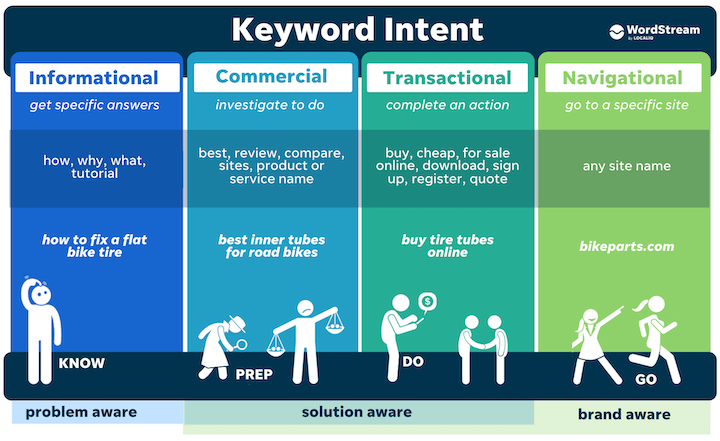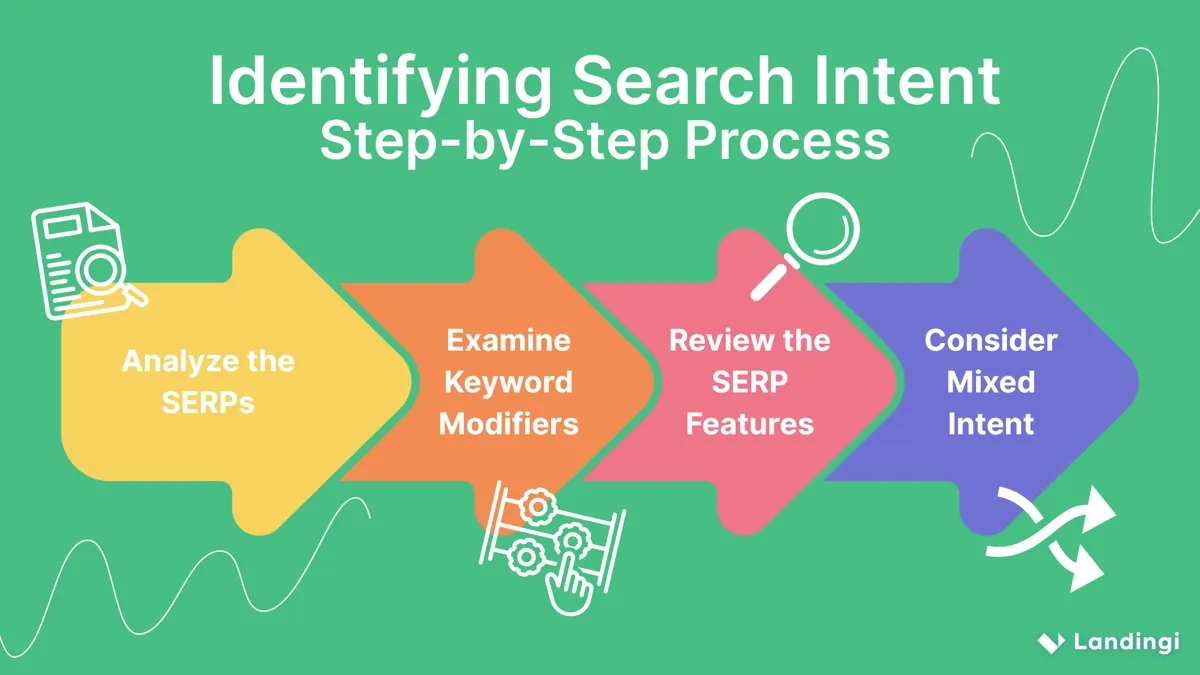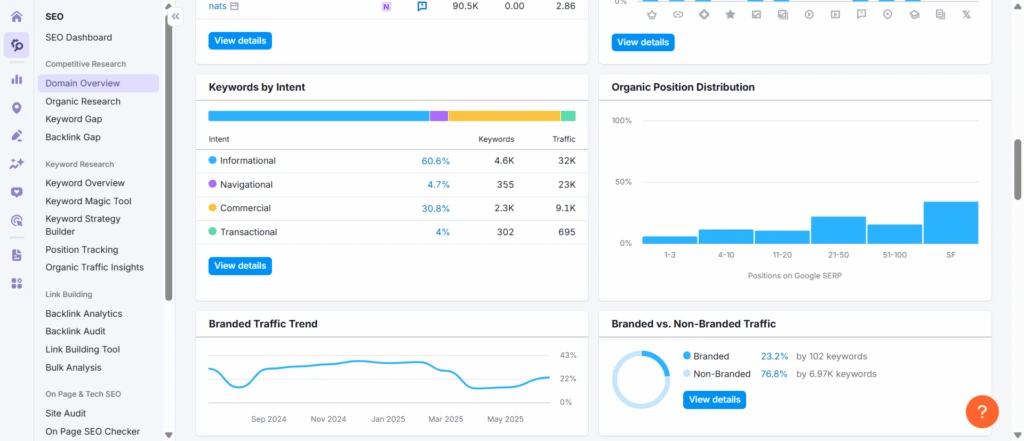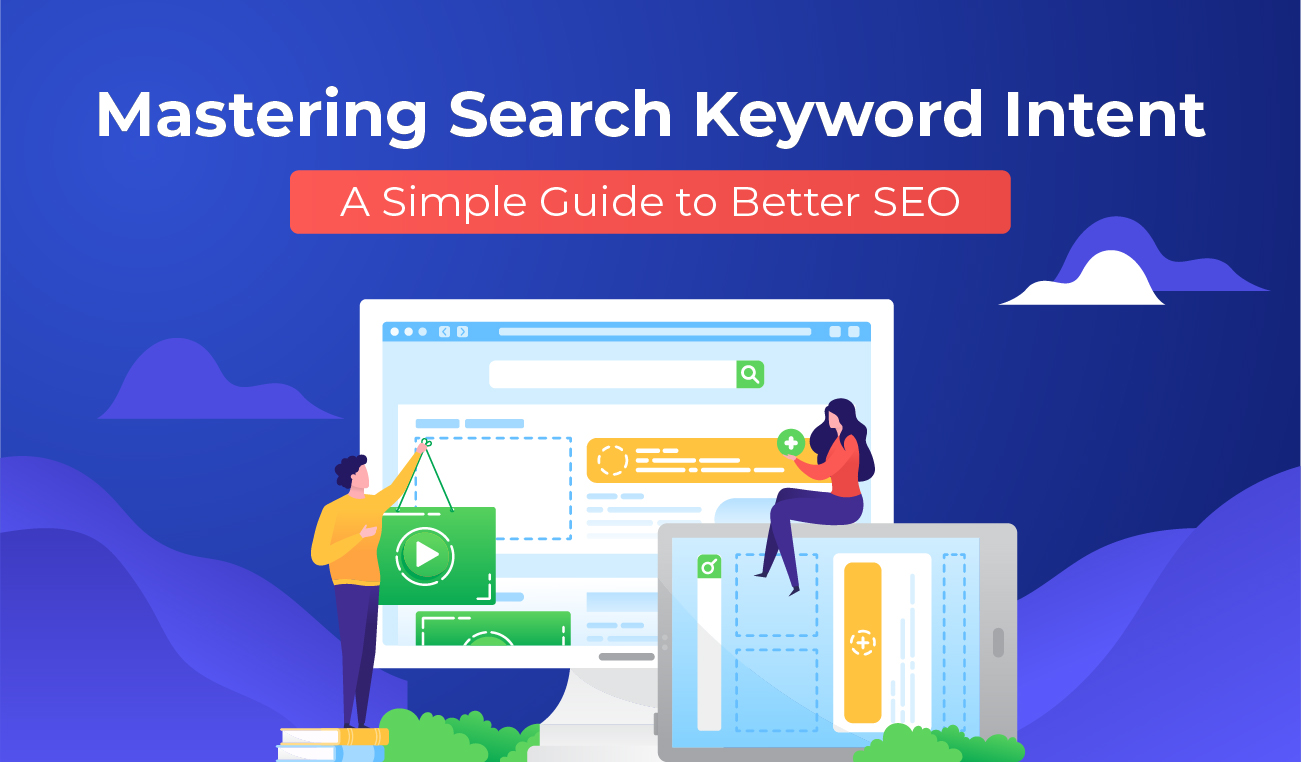20 years ago SEO used to be dictated by stuffing as many “keywords” in the content and meta tags as possible. The general belief was that google would rank pages for those specific keywords added in the content.
But those early days of search are long gone. Search engines, especially Google have now become smart enough to very accurately decipher the meaning or intent behind search keywords and give precedence to the intent behind the keywords rather than the literal meaning of the keywords.
But website owners haven’t really got the hang of keyword intent even in 2025. A surprisingly large percentage of companies still don’t consider keyword intent while creating content. This oversight is a vital factor that determines SEO success, or failure.
Many of us know the frustration. We spend countless hours optimizing content and it stays stuck on page two or three of search results. The biggest problem isn’t about choosing keywords. It stems from not understanding what users really want when they search those terms on Google.
Search intent (also called user intent) ranks as the top factor that determines your content’s success or failure. Understanding different types of keyword intent isn’t just useful – it’s a must for anyone who wants better SEO results.
Your content needs to match what people search. This approach works whether you want to educate, guide, or make sales. The right content that answers your audience’s questions will boost your results significantly.
This article breaks down the meaning of keyword intent in SEO. You’ll learn about the four main types and how to optimize your content for each one. Let’s head over to transform those search queries into measurable results!
What is Keyword Intent in SEO?
People type search queries into Google with specific goals in mind. This purpose behind each search is what we call keyword intent. It reveals the “why” that makes someone look for specific information online.
Keyword intent (also called search intent or user intent) shows what people want to achieve with their searches. The concept helps us understand what users really hope to find.
Take someone searching “buy chia seeds” – they’re ready to make a purchase. Someone typing “what are chia seeds” wants simple educational information about chia seeds. These differences are the foundations of a working SEO strategy.
Google has made search intent the life-blood of its ranking algorithm. The company’s Google’s Quality Rater Guidelines put heavy emphasis on search intent. They’ve released a report called “How Search Intent Is Redefining the Marketing Funnel” that shows its growing importance in the digital world.
Google’s smart ranking algorithms have grown far beyond matching keywords to relevant pages. They now use semantic search to decode complex queries and grasp user context. This makes intent recognition more vital than ever.
SEO experts say that traditional ranking signals like backlinks still matter. Yet your page won’t rank well if it doesn’t meet the search intent behind a query. This has altered the map of how we approach SEO.
Search queries usually fall into four main categories:
- Informational Intent: Users want to learn something new or get answers. These searches often start with “how,” “what,” or “guide.” Example: “how to use a DSLR camera”
- Navigational Intent: Users look for specific websites or pages. They know what they want and use search as a shortcut. Example: Searching for “Facebook login”
- Commercial Intent: Users research before buying – the “tell me more” phase. Example: “Canon Powershot Elph 360 review”
- Transactional Intent: Users want to take action – buying something, signing up for services, or downloading resources. Example: “buy Canon EOS Rebel T7i”
Finding the intent behind keywords isn’t always easy. In spite of that, you can spot search intent by looking at:
- Words in the query (like “buy,” “how to,” or “what is”)
- Google’s current search results for that term
- SERP features (shopping results, knowledge panels, etc.)
To name just one example, see the keyword “backlink checker.” Google’s results show mostly tools rather than articles about how these checkers work. This shows users want to use a tool, not read about one.
The term “best backlink checker” brings up content that compares different tools. This small change in wording affects the intent and the content that ranks.
Knowing keyword intent helps beyond rankings. It creates better user experiences, targets ideal customers better, and increases conversion rates. Your content becomes more valuable to both search engines and humans when it matches user needs.
Keyword intent optimization does more than place keywords correctly. It creates content that matches what users try to accomplish with their searches. As Google improves its algorithms, meeting user intent has become the main goal for both the search engine and successful SEO experts.
Why Understanding Search Intent Matters
Improves content relevance and rankings
Keyword stuffing is ancient history. Search engines now give priority to content that lines up with what users want. Your rankings go up when your content matches what users are actually looking for.
Google’s algorithms have changed a lot. They don’t just match keywords to pages anymore. Now they use semantic search to understand complex queries and user context. Your content needs to address what users are really looking for, not just target specific terms.
Google’s helpful content update gives priority to useful content over content made just to rank. You can create content that matches what users search for by understanding keyword intent, which helps you rank better.
Matches user expectations
Users are more likely to participate when they find content that matches their search intent. They read the whole article, watch videos, and check out related content on your website.
Content that matches user intent creates a better experience. Users spend more time on your site and bounce rates drop. Users who find what they need will:
- Feel more satisfied and stay longer
- Come back more often
- Support your brand
- Stay more involved
Matching your content with user intent is key to giving users a good experience. Google spots when users don’t like search results and lowers the ranking of pages that don’t meet expectations. Users who have a good time on your website will come back and tell others about it.
Boosts conversion rates
The best reason to focus on search intent is how it helps your bottom line. The average conversion rate across 14 industries is 2.7%. You can beat this standard by a lot if you optimize for keyword intent.
Your content becomes more convincing when it lines up with what users are searching for. This works because you solve user problems and give solutions that make them take action.
High-intent keywords are great because they show users are ready to act—whether they want to buy something or use your site. You connect with people at the perfect time in their buying experience by targeting these terms.
Your content can help users at different stages of buying when you understand and optimize for different types of intent:
- For informational intent: Build trust with helpful content that shows you know your stuff
- For commercial intent: Help users choose with detailed comparisons and reviews
- For transactional intent: Make pages with clear calls-to-action that make buying easier
Your call-to-action (CTA) should match user intent and where readers are in their customer experience. Informational searches work better with simple CTAs that let users learn more, while commercial and transactional searches need direct conversion CTAs.
Making search intent a priority in your SEO strategy goes beyond rankings—it’s about creating content that helps your audience and drives real business results.
The 4 Main Types of Keyword Intent

Image Source: WordStream
Different types of keyword intent give you the ability to create targeted content that connects with users at every stage of their experience. Research shows that about 80% of all queries are informational. The remaining 20% is divided among navigational, commercial, and transactional keywords. Let’s look at each type in detail.
Informational: Learning something new
Users show informational intent when they search for knowledge, answers, or guidance about specific topics. These searches usually start with words like “what,” “how,” “who,” “when,” and “why”. To name just one example, someone who types “what is blockchain?” or “how to bake muffins” wants educational content rather than shopping options.
These users stand at the beginning of their buying experience. They gather information, start new projects, or research potential purchases. Google understands informational intent beyond simple definitions. Someone searching for “tomato sauce” probably wants recipes instead of a culinary history lesson.
To optimize for informational keywords:
- Create detailed, educational content
- Answer specific questions clearly
- Include visual aids where appropriate
- Focus on establishing expertise rather than selling
Navigational: Finding a specific site
Navigational intent shows up when users know exactly where they want to go. They use search engines as shortcuts to reach specific websites or pages instead of typing full URLs.
People often search for “Facebook login,” “Google Search Console,” or specific brand names. These searches indicate strong brand recognition and loyalty. This behavior matches a customer who walks straight to your store and ignores all competitors.
Navigational queries make users’ lives easier. Brand domains aren’t always obvious – Peloton’s actual domain is onepeloton.com – which makes search the preferred way to navigate.
Google calls this a “go query” and has reduced first-page results to seven for navigational searches. This change led to a 5.5% drop in organic first-page listings.
Commercial: Comparing before buying
Commercial intent bridges the gap between informational and transactional searches. These users plan to buy soon but need more time and convincing. They research options, compare products, and evaluate alternatives before making purchases.
These searches often include terms like:
- “Best coffee maker”
- “Canon 6D review”
- “Samsung Galaxy price”
- “Alternatives to Adobe Photoshop”
Commercial intent helps businesses influence target audiences during the vital consideration stage. This stage matters most for products or services that get pricey, complex, or have significant impact.
Semrush’s Organic Research tool shows that keywords with full or partial commercial intent drive 72.22% of organic visits per month to bestbuy.com and 63.89% to kay.com.
Transactional: Ready to take action
Transactional intent reveals users who want to complete an action—usually making a purchase. These searchers know what they want and need to find that product or service page quickly.
These valuable keywords typically include terms like:
- “Buy Apple iPhone”
- “Mangools subscription”
- “Netflix discount”
- “Cheap laptops for sale”
Transactional keywords are gold for e-commerce businesses because they lead directly to conversions. These users have finished researching and stand ready to act.
Search results for transactional keywords display many ads, including shopping ads with product images and prices. You’ll see pages from e-commerce sites, with category and product pages taking priority over informational content.
The quickest way to optimize for transactional intent focuses on driving conversions through clear calls to action, persuasive product descriptions, special offers, and smooth checkout processes.
Each intent type shows a different stage in the customer’s experience. Understanding how to spot and optimize for each type helps you create content that matches user needs throughout their journey.
How to Identify Keyword Intent
Image Source: Landingi
Understanding the intent behind keywords needs both analysis and gut feeling. You need practical ways to figure out which category your target keywords belong to once you know the four types of keyword intent. Let’s get into four proven ways to spot keyword intent accurately.
Look at the language of the query
Search queries often show what users want through their words and phrases. The specific language reveals the user’s goals.
These modifiers point to specific intent types:
- Informational intent: Queries with “how,” “what,” “who,” “when,” “why,” “guide,” “tutorial,” “tips,” “examples,” and “resources”
- Commercial intent: Words like “best,” “top,” “review,” “comparison,” “vs,” and specific product features
- Transactional intent: Terms such as “buy,” “discount,” “coupon,” “price,” “order,” “cheap,” and “free shipping”
- Navigational intent: Brand names, product pages, service names, or location terms
Word order in queries matters a lot because different arrangements show different intents. To name just one example, “ingredients for dog food” shows users want recipes to make dog food at home, while “dog food ingredients” shows they want to learn about what’s in store-bought dog food.
Analyze the top-ranking pages
Google has done much of the intent analysis work already. Their algorithms know which content best matches what users search for.
Search your target keyword and look at the top 10 results. Find patterns in:
- Content formats (articles, product pages, comparison charts)
- Topics covered
- Page structures
- Writing style and depth
If most top pages for “toaster oven” show product listings and comparison pages instead of information, this points to commercial or buying intent.
Check for SERP features
Google’s SERP features are a great way to get insights into what users want. Different features show up based on what Google thinks will help the searcher most.
SERP features and what they mean:
- Featured snippets and knowledge panels: Usually show information-seeking intent
- Shopping results and product listings: Point to buying intent
- Local packs with maps: Show local intent (often for purchases)
- “People Also Ask” boxes: Show related questions about the topic
- Video results: Show users want visual guides or explanations
Ads can also point to commercial or buying intent—higher bids and competition in Google Ads usually mean stronger commercial intent.
Use keyword research tools
Manual analysis helps, but specialized tools can make finding keyword intent much faster.
Semrush and Ahrefs now have features that sort keywords by intent automatically. Semrush’s Keyword Magic Tool shows intent categories right in its interface, marking keywords as informational, navigational, commercial, or transactional.
Other helpful tools include:
- Google Search Console: Shows which keywords bring traffic to your site
- AnswerThePublic: Creates question-based queries about your topic
- thruuu: Analyzes SERPs to find main intent types
- ChatGPT: Helps sort and group keywords by intent
Experts say your analytics data shows if your content matches user intent. High bounce rates from search traffic might mean your content doesn’t match what searchers want.
These four methods—looking at query language, studying top-ranking pages, checking SERP features, and using specialized tools—help you learn about the intent behind your target keywords.
Using Keyword Modifiers to Detect Intent
Keyword modifiers give us clear signals about user intent in search queries. These extra words and phrases add context to main keywords. They make searches more precise and targeted. A simple keyword like “shoes” becomes “running shoes,” which shows either commercial or transactional intent based on other modifiers.
These intent-signaling modifiers help you quickly sort searches and create content that matches user needs. Let’s look at the most common modifiers for each type of intent.
Modifiers for informational intent
About 80% of all searches show informational intent. Users add specific words that show they want to learn something:
- Question words: who, what, when, where, why, how
- Learning terms: guide, tutorial, resources, examples
- Clarification terms: meaning, define, explanation
Users who add these modifiers are usually at the start of their buying trip. They might research a future purchase or begin a new project, but they’re not ready to buy yet.
Modifiers for commercial intent
Commercial intent keywords show that users are looking at options before buying. These users know about possible solutions and want to explore their choices. They have money to spend but need more information before they decide.
These modifiers point to commercial intent:
- Comparison terms: best, top, vs, comparison, alternative
- Evaluation terms: review, pros and cons
- Specific product attributes: features, specifications
- Research phrases: refurbished, used, new, online
Semrush data shows that keywords with commercial intent bring over 72% of monthly organic traffic to major retail websites like BestBuy.com. These modifiers show users are comparing options before making their final choice.
Modifiers for transactional intent
Transactional intent keywords tell us users are ready to act – usually by making a purchase. These valuable keywords convert well because they target users who are ready to buy.
The most powerful transactional modifiers include:
- Purchase terms: buy, order, subscribe
- Deal-seeking terms: discount, coupon, sale, cheap, affordable
- Urgency indicators: overnight shipping, same-day delivery
- Action phrases: download now, sign up, free shipping
“Buy” and “order” stand out as the strongest transactional modifiers. They clearly show intent to purchase. Words like “discount” and “coupon” also signal buying intent, though users might want incentives to choose between competitors.
Some keywords can mix different types of intent. “Landscaping boston” shows both commercial and local intent. “Best spf reddit” combines commercial and navigational intent as users look for product recommendations on a specific platform.
A careful analysis of these modifiers in your target keywords helps create content strategies that match user needs at every stage of their decision process.
Optimizing Content for Each Intent Type
Image Source: ThatWare
You need more than just understanding keyword intent to create good content—you must optimize for each intent type. Users have specific expectations that your content must meet after you identify what they want.
Match content format to intent
User needs vary based on search intent types, requiring different content formats. Detailed blog posts, how-to guides, and educational resources work best for informational intent. Commercial intent searches need comparison pages, alternatives pages, and detailed reviews. Product pages, pricing information, and purchase-focused content serve transactional queries better.
Podcasts, social media posts, blog articles, and research reports perform well for awareness and discovery (top of funnel). Tools, quizzes, product videos, and newsletters work best as users move to consideration (middle of funnel). Comparison pages, case studies, and product demonstrations become crucial at the decision stage (bottom of funnel).
The biggest mistake happens when you ask too much too early—case studies won’t help users still exploring solution types.
Use intent-aligned CTAs
Your calls-to-action should match where users are in their trip. Softer CTAs like “Learn more” or “Sign up for updates” work for informational searches. Guide users toward evaluation with “Compare options” or “See features” for commercial intent.
Direct purchase paths with “Buy now,” “Order today,” or “Get started” buttons serve transactional intent best.
Dale Bertrand, SEO expert, notes: “Intent-driven content and CTAs help you confidently prove content marketing effectiveness, overcoming skepticism and securing buy-in from the C-suite”.
Structure content for clarity
Content structure affects both user experience and SEO performance greatly. Clear headings, short paragraphs under 50 words, and bullet points make informational content readable. Text becomes easier to digest with relevant images.
Comparison tables to present options clearly work well for commercial intent. Users make better decisions with product feature lists and specification charts.
Transactional pages need prominent CTAs, concise offer descriptions, and compelling visuals. Product features, benefits, and calls to action should stand out.
Search engines prefer well-laid-out content because it leads to longer dwell time and lower bounce rates—showing that your content meets user intent.
Note that rankings aren’t the only goal—solving ground problems for your audience matters more. Trust, authority, and conversions grow when you solve problems through properly formatted, intent-aligned content.
Advanced Intent: Mixed and Layered Queries
Search intent goes beyond the four simple categories – queries often carry multiple layers of meaning. Search engines need to figure out searches that combine different types of intent.
Understanding overlapping intent
Searches often blend two or more types of intent. Someone who looks up “blog platform free” might want to learn if blogging costs anything (informational) and check out different options (commercial) at the same time.
Google’s quality rater guidelines talk about this complexity. They acknowledge that keywords can mean different things to different users. The search engine must figure out the strongest intent to show the most helpful results.
How to handle multi-intent keywords
Keywords with mixed intent present a strategic challenge. Your content should focus on the strongest intent rather than trying to cover everything at once – that rarely works well.
Here’s how you can spot the dominant intent:
- Look closely at SERPs to find patterns in content types
- See if related terms show similar SERP results
- Check if rankings stay stable – this usually points to clearer intent
After you’ve spotted the main intent, create content that really tackles it head-on. John Mueller from Google points out that “mixed content intents within webpages can confuse Google Search”.
Examples of layered search behavior
Mixed intent shows up in many ways:
- “How to make sourdough bread” – People want more than just steps – they need troubleshooting help and creative ideas too
- “Noise canceling headphones” – While buyers want to purchase, they first need to compare options
- “Heirloom vegetable seeds” vs. “native vegetable seeds” – These searches look similar but reveal different needs (globally old varieties vs. locally native plants)
This complexity needs smart content planning. Pages that rank for different intents often work better when split into focused pieces. Search engines understand the content better, and users get exactly what they need.
Tools to Help You Analyze and Apply Intent

Tools designed for keyword intent analysis can make the process smoother and faster. These specialized solutions give you deeper understanding of search intent patterns while saving your time.
Google SERP and People Also Ask
Google Search Engine Results Page (SERP) gives you valuable hints about keyword intent without any cost. The type of ranking pages tells a story – product pages point to transactional intent and detailed guides suggest informational intent. The SERP features add more clarity:
- Shopping results → Transactional intent
- Featured snippets → Informational intent
- Local packs → Commercial/local intent
People Also Ask (PAA) boxes are a great way to get intent information through related questions users search. These questions tell you what people want to learn about a topic. Your content will naturally line up with user intent when it answers these questions.
Semrush and Ahrefs intent filters
Professional SEO tools come with automated intent classification features:
Semrush’s Keyword Magic Tool labels intent categories (informational, commercial, navigational, transactional) right in its interface. The tool costs INR 11809.04 per month and lets you filter keywords by intent to see what drives traffic to competitors.
Ahrefs provides AI-powered intent classification at INR 8353.66 monthly. The system categorizes keywords into four intent types:
- Informational: Users seeking information
- Navigational: Users finding specific websites
- Commercial: Users comparing options
- Transactional: Users ready to take action
ChatGPT for quick classification
ChatGPT and similar AI tools can cut down keyword categorization time from 15-30 hours to under 2 hours for websites that get about one million yearly visitors.
ChatGPT makes intent analysis simple:
- Paste your keyword list
- Ask it to categorize by intent type
- Request elaboration on mixed-intent keywords
ChatGPT goes beyond simple classification and spots content gaps in your pages. This helps ensure your content addresses user intent fully.
Conclusion
Keyword intent remains one of the most powerful yet underused SEO strategies accessible to more people today. Though 76% of companies ignore keyword intent in their content creation, you can now gain a substantial competitive edge.
Search engines have evolved far beyond simple keyword matching. Google now rewards content that truly meets user needs through its sophisticated algorithms and semantic search capabilities. This radical alteration means your SEO success depends on your ability to decode what users really want from specific queries.
The four intent categories—informational, navigational, commercial, and transactional—work as your blueprint to create perfectly arranged content. Each type represents a different stage in the customer’s trip and needs specific content formats and CTAs. Note that informational queries comprise about 80% of all searches, while commercial intent keywords drive over 72% of organic visits to major retail websites.
Keyword modifiers give valuable hints about why it happens. Question words like “how” and “what” point to informational intent, while comparison terms like “best” and “review” suggest commercial intent. Words such as “buy” and “discount” show strong transactional intent from users ready to convert.
Many queries show mixed or layered intent—which needs careful analysis to find the main intent. Google’s quality rater guidelines address this complexity and acknowledge that many keywords carry multiple possible user intents.
Tools like Semrush, Ahrefs, and even ChatGPT make your intent analysis process smoother. These resources help you save time while learning about search intent patterns.
Content that matches user intent creates better customer experiences, makes targeting more effective, and improves conversion rates substantially. Users who find exactly what they seek stay longer on your site and interact more.
Your SEO strategy must grow beyond basic keyword placement. The core focus should be creating content that matches what users truly want to accomplish during their search. This approach satisfies both search engines and builds trust with your audience—converting casual visitors into loyal customers.
Becoming skilled at search keyword intent takes practice, but the results make every effort count. These principles, when applied today, will help your rankings, traffic, and conversions grow.
FAQs
Q1. How can I optimize my content for different search intents? To optimize for different search intents, match your content format to the intent type. Use comprehensive guides for informational queries, comparison pages for commercial intent, and product pages with clear CTAs for transactional searches. Ensure your content structure and calls-to-action align with where users are in their journey.
Q2. What are some common keyword modifiers that signal different search intents? Informational intent often includes modifiers like “how,” “what,” or “guide.” Commercial intent typically uses terms like “best,” “review,” or “vs.” Transactional intent is signaled by words such as “buy,” “order,” or “discount.” Recognizing these modifiers helps you quickly categorize searches and create aligned content.
Q3. How do I identify the dominant intent for keywords with mixed or layered intent? To identify dominant intent for mixed keywords, analyze SERPs carefully, looking for patterns in content formats and types. Check for SERP similarity between related terms and assess SERP volatility. Once you’ve determined the primary intent, create focused content that thoroughly addresses it rather than attempting to cover everything.
Q4. What tools can help me analyze keyword intent more efficiently? Several tools can streamline keyword intent analysis. Google’s SERP features and People Also Ask boxes offer valuable clues. Paid tools like Semrush and Ahrefs provide automated intent classification. Additionally, AI tools like ChatGPT can help quickly categorize keywords by intent type and identify content gaps.
Q5. Why is understanding keyword intent crucial for SEO success? Understanding keyword intent is crucial because search engines now prioritize content that genuinely satisfies user intent. By aligning your content with what users actually want, you improve relevance and rankings, meet user expectations better, and ultimately boost conversion rates. This approach creates better customer experiences and more effective targeting of ideal customers.
About The Author
Get A Free 1 Hour Consultation
I can help you fix your digital marketing strategy that powers your business growth.
No strings attached. No commitments required. No sales pitch from my side about our services. I will give you a patient hearing, understand your business, understand your business growth challenge and suggest various growth strategies you can implement for your business. I will talk about my service offerings, only if you want me to. Not otherwise.


